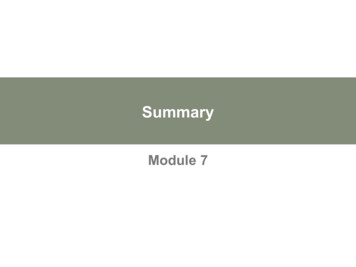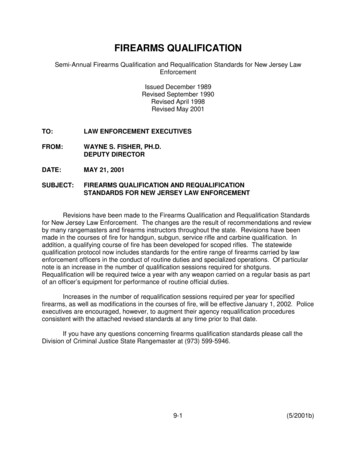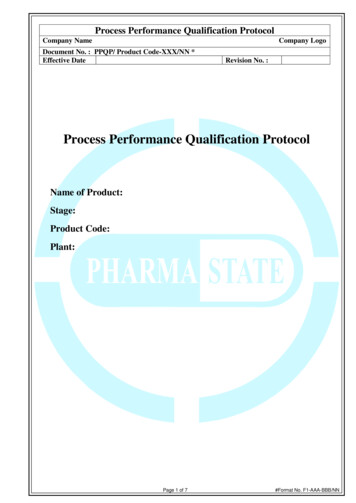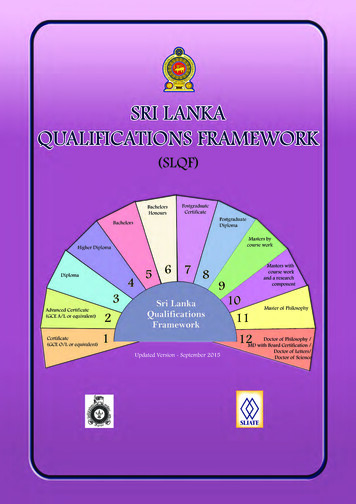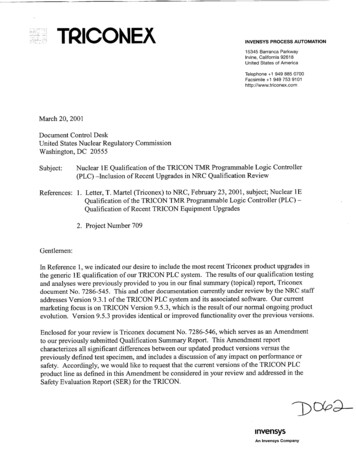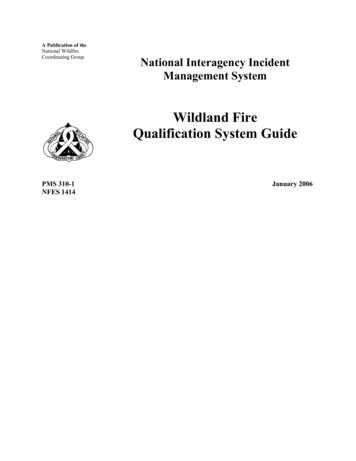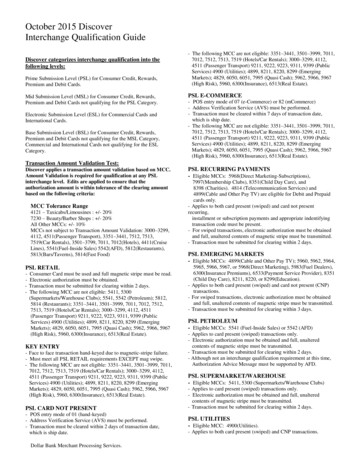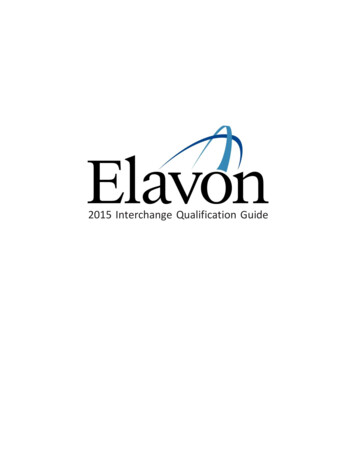
Transcription
U.S. Coast Guard AuxiliaryNational Department of Human ResourcesAUXFSTraining andQualificationGuideApproved by Coast Guard and Coast Guard Auxiliary-- April 2014
This page intentionally blank.
Table of ContentsIntroductionChapter 1: Overview of the AUXFS Program History Goals and benefits Administrative issuesChapter 2: Coast Guard Food Services OverviewChapter 3: Tools and Equipment Introduction of the concepts of food and non-food contact surfaces and thevarious types of food service tools, equipment and utensils used in preparing,holding, serving and storing foodChapter 4: Sanitation and Safety Instruction on how food becomes unsafe and guidelines for keeping food safe,including personal hygiene. Instruction for cleaning and sanitizing equipment. Instruction on knife handling.Chapter 5: Introduction to Food Preparation Introduction of basic cooking principals, meal planning, recipe conversions,knife skills Herbs and Spices Nutrition PresentationChapter 6: VIP Events and other AUXFS DutyChapter 7: Hands-on meal planning, preparation, and servingChapter 8: Performance Qualification StandardsAppendicesResourcesA.B.C.D.AUXFS ResourcesAUXFS UniformsAUXFS Health Record Verification ALCOASTAUXFS PQS and Health Record Verification Forms
IntroductionThis Guide has been developed to provide training to the AUXFSs that is consistentwith the training given to the Coast Guard Food Service Specialists. The Guide is basedon Food Services Specialist, Third Class Performance Qualification Guide.Auxiliarists who cook at Coast Guard stations, cutters, or VIP events are required to takethe AUXFS training. The AUXFS designation demonstrates to the Coast Guard FoodService Specialists that an Auxiliarist has the training and experience necessary tocomply with Coast Guard policies and procedures.There are three parts to the AUXFS training:1. Classroom training of approximately14 hours2. “Hands-on” training of approximately 8 hours where a meal is planned,prepared, and served.3. Accomplishment of Performance Qualifications to be performed withinone year of completion of AUXFS training and signed off on by anAUXFS mentor or unit Food Service Specialist.ReferencesThe following references will be used during the training and subsequent AUXFSduty. AUXFS Training and Qualifications GuideCoast Guard Food Service Manual, COMDTINST M4061.5 (series)Food Service Practical Handbook, COMDTPUB P4061.4Food Service Sanitation Manual, COMDTINST M6240.4 (series)Auxiliary Manual, COMDTINST M16790.1GProfessional Cooking, 7th Edition by Wayne GisslenVarious handouts specified by the National Auxiliary AUXFS Program or theCoast Guard Food Services Program.
Chapter 1: Overview of the AUXFS ProgramHistoryAfter 9/11, it became obvious that Auxiliarists had many new roles that they couldplay as part of Team Coast Guard. Auxiliarists had been informally supporting stationsand cutters by helping in the galleys. In 2006, through the efforts of District 1SR, theAuxiliary Chef (AUXCHEF) program was approved as a pilot program. District 5SR thenspearheaded its development, serving at small boat stations, on cutters, and at VIP eventsthroughout the 5th District. In January 2009, the National Commodore and NationalExecutive Committee approved the AUXCHEF Program as an Auxiliary NationalProgram and this guide was officially adopted in 2010. In 2013, the AUXCHEF programwas renamed the AUXFS program to more closely resemble in both name and practice thepolicies and standards required of active duty Coast Guard Food Service Specialists.Goals of the AUXFS Program Give Auxiliarists another means to contribute to and support the Gold Side. Provide simple Food Service training to Auxiliarists. Relieve the Food Service Specialists (FSs) at small boat stations and cutters sothat they can take leave, attend “C” schools or other training, or perform otherduties. Provide assistance at Coast Guard and Auxiliary VIP events. Provide training and support to Food Service Specialists (FSs). Improve the morale of Coast Guard personnel. Demonstrate to the Gold Side the importance and diversity of the Auxiliary. Support the Coast Guard and Auxiliary in emergencies. Add to the activities in which Auxiliarists participate, adding interest to theircareer. This is important to recruiting and retention.Qualifications A desire to help and support the active duty Coast Guard Cooking experience not a requirement. Available time to volunteer. Completion of the AUXFS Training Program and PQSs, including TCT(if required by the Coast Guard unit they’re supporting) and getting theHEP A vaccination. Be qualified as an Auxiliary instructor in order to becertified as an AUXFS instructor.Duties of AUXFSsUnder the supervision of the unit Food Service Officer (FSO) and/or Senior AUXFS, atrained AUXFS will: Plan meals and shopping listsNOTE: AUXFSS shall not do any direct purchasing, with or without aunit credit card, as this would be a violation of Coast Guard and federalpolicies and regulations. Prepare meals
Serve meals Some clean up
Program AdministrationStructure of the AUXFS ProgramAt the National level, the AUXFS Program will be implemented andadministered by AUXFS Division within the National Department of HumanResources.The District Commodore will appoint a District AUXFS Chair. The Chair will beresponsible for implementing and administrating the AUXFS Program at theDistrict level. The District Commodore may appoint subordinatechairs/leaders at the Sector, Division, or unit level as needed, in consultation withthe District AUXFS Chair.The Director of Auxiliary in each District will support the AUXFS to theextent possible.Assignmentso The AUXFS Chair will work with the Sectors to disseminateinformation on the AUXFS Program to the units.o The Coast Guard unit will request assistance through the District AUXFSChair who will then ask for AUXFS volunteers in the area and will makethe assignment. This task may be delegated to an AUXFS leader at theSector or Division level.o The AUXFS Chair will consult with the Unit OIC.o Duty time may be from one meal to several weeks depending on thenature and location of the duty and the needs of the unit.o AUXFSs assigned to a cutter must be physically able to handle theduty. The AUXFS Chair or unit OIC will make this determination.OrdersGenerally the unit being supported will provide them.o The type of orders depends on the duty unit Non-Reimbursable Orders Reimbursable Orders May cover mileage outside the normal commuting area.o Berthing and meals are usually provided by unit, and must be reflected onorders.Health Issueso Hepatitis A Shots are required. The Coast Guard can provide the shotsat a Coast Guard health care facility if supplies and operations allow.However, all AUXFS must provide proof of their vaccination inaccordance with Appendices C & D.o The AUXFS must be physically able to handle the assignment.
Uniformo The ODU is generally the required uniform for AUXFSs working at aStation or on a cutter. However, a Unit may prescribe a different uniform.(See Appendix C for uniform details)o For VIP events, a white chef coat, black pants, and black shoes will berequired. There are many sources for inexpensive chef clothing.AUXFS in AUXDATAo AUXFS is a competency in AUXDATAo When an AUXFS completes: the PQS is current on TCT (if applicable) and has had the Hep A vaccination, the AUXFS canbe entered into AUXDATA as “Qualified”o The District Chair certifies to the District DIRAUX that theAUXFS meets the requirements and can be entered intoAUXDATA.Reporting Time for AUXDATA For AUXFS duty at or in support of a Coast Guard Unito Report time on the 7030 (Mission Activity Report) using Mission Code 07D(CG Operational Support) Put “AUXFS Duty” in the Remarks Section with details of the duty– this allows the IS Officer to enter time under the AUXFSOperational Code) Enter the appropriate OPCON Code Record only the time actually spent on FS/AUXFS duties Record no more than 19 hours per day – unless on a cutter where up to24 hours can be recorded.For AUXFS duty in support of Auxiliary unitso Report the time on the 7029 (Member Activity Log) under 99E (AuxiliaryAdministrative/Logistical Support) Put “AUXFS Duty” in Mission Description with the details of theduty - this allows the IS Officer to enter time under the AUXFSOperational Code Record only the time actually spent on AUXFS duties Record the AUXFS hours separately from other 99E hoursFor preparation and travel in support of all AUXFS duties, report these hours on the7029 (Member Activity Log) under 99BSubmit the forms to the FSO-IS as with any mission forms.If submitting the forms electronically, add the email of your District Chair in the“SUMBIT” area, so the Chair gets a copy.ProtocolThe protocol outlined in Chapter 12 of the AUXMAN must be followed whenserving at a station or on a cutter. For VIP events, the FS personnel in chargewill provide any additional protocols.
On-going TrainingAUXFSs will be required to take: The 8-hour TCT class every two years, if the CoastGuard unit they are supporting requires it. An annual Sanitation Workshop as is required by the Coast Guard for allFood Services personnel.Advanced training will often be given at the District level. Such training wouldexpand on subjects in the AUXFS Training Guide (i.e. healthy cooking) orcover special skills (i.e. baking). The curricula will be developed and/orapproved by the National AUXFS staff.Unit FSs will also be giving “on-the-job” training to AUXFSs while they are onduty. The AUXFSs may also be providing “on-the-job” training to theunit FSs.
Chapter 2: Coast Guard Food Services OverviewFood Service Specialists (FSs) are found in nearly all Coast Guard duty stationsthroughout the world and on almost every cutter.The functions of the CGDF are 1) Administration, 2) Records and reports, 3) Foodstorage and 4) Food preparation and service.CGDF spaces may include storerooms, refrigerators, vegetable preparations areas,bakeries, galleries, crew dining room, and sculleries.Personnel/Command StructureThe Administrative Structure is the same in all CGDFs.1. The unit Commanding Officer or Officer in Charge has overallresponsibility for the facility.2. The unit Executive Officer or Executive Petty Officer has supervisoryand administrative functions.3. The Food Service Officer (FSO) oversees the actual day-to-dayoperations and assigned food service personnel activities.4. Senior Food Service Specialist assists the FSO in organizing, planningand directing operations.5. Jack-of-the-Dust handles daily issues, such as receiving and storingsubsistence items.6. Mess Attendants (mess/duty cooks) assist in many of the duties,including cleaning.Depending on the size of the unit, the FSO may perform several of the functions.
Overview of the Food Service EnvironmentThe CGDF may contain the following: Galley – food preparation and holdingServing Line – plates and utensils, serving equipment (steam tables andcold serving bars), cooking surfaces for cook-to-order foodMess Deck – drink dispensers, chilled salad bar, tables and chairsScullery – food disposal areas, sinks, dishwashers/sanitizersFood Storage –dry storage, refrigerators, and freezers
Chapter 3: Tools and EquipmentThe equipment in a CGDF is essentially the same, which is designed as a commercialkitchen. During training and duty, the FSO will describe the available equipment andtheir uses.AUXFSs may want to bring their own knives, thermometers, measuring spoons,measuring cups, and other basic equipment. A small tackle box is a good way to carrypersonal equipment.Some general rules for using equipment at a station or on a cutter. Never use a piece of equipment until you are thoroughly familiar with itsoperation and features. Read the manual and/or ask someone who is familiar with the equipment. Keep the equipment clean. Use equipment in a way to conserve energy. Know when it is better to use a manual method rather than a piece ofequipment.COOKING EQUIPMENTCooking tools and equipment are essential for preparing extraordinary food and drink –the kind of meals that people keep coming back for. When used and maintained properly,your cooking equipment will serve you well. This same equipment can also be verydangerous. In addition, cooking equipment when used or maintained improperly canbecome very expensive.Equipment can burn, cut, or smash various parts of the body. Make sure that you arefamiliar with the equipment before you use it. Also, learn to recognize when theequipment is not working properly.This is an introduction to many commonly used pieces of equipment. The best source ofinformation about a piece of equipment is the owner’s manual. Other sources ofinformation on the equipment are Professional Cooking by Wayne Gisslen and the FoodServices Practical Handbook, COMDTPUB 4061.4. All of these resources will be foundin the CGDF.Range topsThis is the most important piece of equipment in the galley. The most common rangeoften has open elements/burners and griddle, which may gas or electric.Some rules: Make sure that the pilot lights are lighted before turning on the burners. Adjust air intake so that gas flames are blue with white tip for maximum heat.
OvensOvens are enclosed spaces in which food is heated. In addition to roasting and baking,ovens may perform many jobs normally done on the range top.ConventionalThey can be part of range unit or a stand-alone unitSome rules:DO be sure that the pilot light is on before turning on a gas oven.DO leave adequate space between items for better heat circulation.DON’T preheat longer than necessary.DON’T open the oven more often than necessary.ConvectionThese contain fans that circulate the air and distribute the heat rapidly throughoutthe interior of the oven. They cook foods more quickly at lower temperatures,may dry out food, and allow pans to be placed closer together.You will reduce the oven temperature by 25- 50 degrees unless otherwisespecified in the operating instructions or recipe.Some rules:DO be sure that the pilot light is on before turning on a gas oven.DO leave adequate space between items for better heat circulation.DON’T preheat longer than necessary.DON’T open the oven more often than necessary.MicrowaveThese are often used for warming leftovers and snack foods. They can also beused for defrosting foods.It is important to read the owner’s manual as models vary in features and power.Some rules:DO watch timing.DO turn over large items for more even cooking.DON’T over load the microwave.Deep fryersThese can be gas or electric. They can also be dangerous if not handled properly. Thisincludes using the right oil. Many units have limited the use of or stopped using deepfryers as they have adopted healthier cooking standards.Some rules:DO make sure the drain valve is shut.DO keep the kettle filled to the fill line.
DO check the accuracy of the thermostat.DO empty and clean the fryer after each use.DO filter the oil after each use.DON’T overload the baskets.DON’T salt food over the fat, as the salt will deteriorate the grease.DON’T fry strong and mild flavored food in the same fat.ToastersThe unit may have either pop-up toasters (up to 4 slices) or conveyor toaster (multiplepieces of bread).PROCESSING EQUIPMENTProcessing equipment is that equipment used to process or prepare food for cooking.Below is information on the most common processing equipment found in Coast Guardgalleys.MixersA bench model mixer has a capacity of 5-20 quarts. It usually has a dough hook (formixing and kneading yeast bread, a paddle (a flat blade for general mixing), and a wirewhip (for beating cream and eggs).Some rules:DO use the correct attachment and make sure that it is attached firmly.DO turn the machine off when changing speed or scraping down the sides of thebowl.DON’T stick hand or spoon into bowl while mixer is on.DON’T wear loose clothing when operating mixer.Food ProcessorsWhen specialized tasks are required, the food processor may be used to shred, dice, slice,grate, or julienne. It can often be used for the same tasks for which a mixer is used.Some rulesDO make sure that it is properly assembled and that the blades are sharp.DO allow blades to stop before opening the bowl.DO wash and sanitize all blades separately and immediately after use.
FOOD HOLDING, SERVING AND STORING EQUIPMENTIt is important to have the unit FS staff explain the operation of all equipment beforeAUXFS duty begins.Hot Food Holding and Serving EquipmentSeveral types of equipment are used to keep food hot for serving. This equipment isdesigned to hold foods above 140 degrees F in order to prevent the growth of bacteriathat can cause disease. Because food continues to cook at these temperatures, it should beheld for as short a time as possible, Food warmers are used to keep food warm for serving and come in many styles.They can be found anywhere in the dining facility. Steam tables are found on the serving line. They can be bench or table. Thetemperature and the water level need to be checked frequently.Cold Food Storage EquipmentThe quality of the food served depends to a large extent on the refrigeration equipment.By keeping food below 41 degrees F, the refrigerator guards against spoilage andbacterial growth. Chilled salad bar, usually found in the mess deck, is used to keep fruits,vegetables, and condiments below the “danger zone” but not frozen. Refrigerators, either walk-in or reach-in, musto Allow for adequate airflow.o Have thermometers on the inside and outside.o Have a thermometer mounted at the warmest spot.o Be monitored daily with temperatures entered into a log.o Maintain food at or below 41 degrees F.o Have emergency escape latches.o Not store food less than 6 inches above the deck. Freezers, either walk-in or reach in, must:o Have thermometers on the inside and outside.o Have a thermometer mounted at the warmest spot.o Must be monitored daily with temperatures entered into a log.o Maintain frozen food at or below 0 degrees F.o Have emergency escape latches.o Not store food less than 6 inches above the deck.
Cleaning and Sanitizing EquipmentThere are various types of equipment used to clean and sanitize the dining facility and itscontents. Manual cleaning and sanitizing equipment requires the use of a three-compartmentsink for washing dishes, glassware, and eating utensils by hand. Pans and cloths maybe cleaned this way as well. The sinks should be cleaned before each use.Water in Sink 1 (washing) should be not less than 110 degrees; in Sink 2(rinsing) 120-140 degrees; and Sink 3 (sanitizing) 171 degrees or greater Mechanical Cleaning and Sanitizing Equipment requires the use of a machine thatthoroughly cleans and sanitizes equipment and utensils. Items are usually rinsed priorto going into the machine. Directions are usually posted in the scullery by themachine.
Pots, Pans, and ContainersThere are many pots, pans and containers of all shapes, sizes and uses. It is important toselect the correct pot, pan, or container that meets the needs for food preparation, servingor storage.Pots Stockpot is a large deep straight-sided pot used for preparing stocks and simmeringlarge quantities of liquids. Saucepot is a round pot of medium depth. It is similar to a stockpot but shallower,which makes stirring or mixing easier. Saucepots should be used for soups, sauces, orother liquids. Brazier is a round, broad, heavy-duty pot with straight sides. It is used for browning,braising, and stewing meats.Pans Saucepan is similar to a small saucepot but with long handle and straight or slatedsides. It is used for general range-top cooking. Sauté pan is straight-sided pan similar to sauce pan but heavier, with a broad surface.It is used for cooking sauces and liquids when rapid reduction is necessary. It can alsobe used for browning, sautéing or frying. Fry pan is a sauté pan with slope sides. It is used for sautéing and frying. Slope sidesmake it easier to flip and toss items. Cast-iron skillet is a very heavy skillet that can be used for a variety of cookingtechniques. Sheet pan is a shallow rectangular pan for baking cakes, rolls, and cookies and forbaking/broiling meats and fish. There are 2 sizes: full pan (18 x 26”) and half pan(18x13”). Bake pan is a rectangular pan about 2 inches deep and comes in a variety of sizes. Itis used for general baking. Roasting pan is similar to a bake pan but heavier and deeper. It is used for roastingmeats and poultry. Hotel pan is also known as a counter pan, steam table pan, or service pan. It isrectangular pan, usually made of stainless steel. It is designed to hold food in servicecounters and can also be used for baking and steaming. When used for baking andsteaming, the food can be served from the same pan.ContainersThese are used for both food storage and preparation. Stainless steel bowls are the mostcommon and are used for mixing and whipping. Galleys will have other storagecontainers.
MEASURING DEVICESMeasuring devices, including such items as scales, measuring cups, and thermometers,play a critical role in food preparation. When used properly, they will help you combineproper amounts of ingredients while preparing food and control portions while servingfood.ScalesScales measure weight of ingredients and food portions. Weight is usually considered amore accurate measure than volume when preparing and serving food. Portion scale is used for measuring ingredients as well as portioningservings.Baker’s scale is used for measuring ingredients for baking for very accurateweight measures.Volume MeasuresThere are several different devices used to measure volume of ingredients or foodportions. Liquid Volume Measures are large containers with a lip for easy pouring.Measuring Cups can be used for both liquid and dry ingredients.Measuring Spoons are used for measuring very small volumes, mostly spicesand seasonings.Ladles are used for measuring and portioning liquids. The size is usuallystamped on the handle.Scoops come in standard sizes and often have levers for mechanical release.They are used for portioning soft solid foods. The number of the scoopindicates the number of level scoopfuls per quart.ThermometersThermometers are very important as they measure the temperatures of food and liquids.Meat thermometer indicates the internal temperature of meats. It is inserted beforecooking and left in during cooking.Instant Read Thermometer gives readings within a few seconds of being insertedin a food product. Carry this type of thermometers in your pocket like a pen. Donot leave it in meats during roasting.Thermometers should be cleaned and sanitized after each use.It is important to routinely calibrate your thermometer Ice-point Method (the preferred method)o Fill container with crushed ice and water
o Submerge the sensing area of the stem in ice water for 30 secondso Adjust calibration nut until the thermometer reads 32 degrees FBoiling-Point Methodo Bring pan of water to a boilo Submerge the sensing area of the stem in the boiling water for 30secondso Adjust the calibration nut until the thermometer reads 212 degrees F.o Note: This method is not always accurate and may be dangerous.KNIVESKnife MaterialThe metals in knives must be able to take and hold an edge. The most common materialsused for making knives are: Carbon steelo Can be easily honed to an extremely sharp edge.o Corrodes and discolors easily.o May leave a metallic taste.Stainless Steel Alloyso Will not rust or corrode.o Hard to sharpen.High-carbon stainless steelo Takes an edge almost as well as carbon steel.o Will not corrode or discolor.
The tang is the portion of the metal blade that is inside the handleHAND TOOLSCooks use a variety of hand tools in the preparation and serving of food. Such toolsinclude spoons, forks, spatulas, tongs, whisks, zesters, and colanders. The unit galley willhave a supply of these. The FSO will explain their uses if necessary.
Chapter 4: Safety and SanitationHOW FOOD BECOMES UNSAFEMicroorganisms are small, single-celled living animals that can only be seen with amicroscope. They are carried by food, water, humans and insects and can reproducerapidly under the right conditions. They are the most prevalent type of biological foodhazard.There are four groups of microorganisms that can contaminate food and cause illness –Bacteria, Viruses, Parasites, and Fungi.BacteriaThere are many different kinds of bacteria. In Food Services, we classify theseinto 4 kinds. Harmless – these are neither helpful nor harmful and not of concern infood sanitation. Beneficial – these are helpful. Many live in the intestinal tracks wherethey fight harmful bacteria and aid in digestion. Undesirable – these cause food spoilage. They may or may not causedisease but do “announce” a problem with food that is discolored, smelly,or with a changed texture. Disease causing (pathogens) – These are dangerous. Eating foodcontaminated with these bacteria is the leading cause of food-borneillnesses. They cannot be seen, smelled, or tasted in food.Bacteria can grow rapidly under ideal conditions. To remember these conditions,use the acronym FATTOM. Food (F) – Bacteria require some kind of food in order to grow. Foodswith sufficient amounts of proteins are best for bacterial growth. Acidity (A) – Harmful bacteria prefer a neutral or slightly acidicenvironment, where the pH is between 4.6 and 7.5. Temperature (T) – Bacteria grow best when the temperature is between 41degrees and 140 degrees, also know as the Danger Zone Time (T) – If PHF remains in the Danger Zone for more than 4 hours;pathogens can grow to levels high enough to make someone ill. Oxygen (O) – some bacteria needs oxygen to grow. Moisture (M) – Bacteria need water to absorb food. Dry foods and foodswith a very high salt or sugar content will generally not support bacterialgrowth.We have the most control over the temperature of food and the amount of time thefood spends in the Danger Zone. Time-Temperature Abuse can occur if food: Is not held or stored at the required temperature Is not cooked or reheated to temperatures that kill microorganisms Is not cooled properly
Is prepared a day or more in advance.FOOD SHOULD NOT BE IN THE DANGER ZONE(41-140 degrees) FORMORE THAN 4HOURS. This includes the time spent loading and unloading and storing thefoods, the time it sits on the counter waiting to be prepared, and the time it isbeing served.
VirusesThese are not as dangerous as bacteria. They need a living host. Food moves thevirus from person to person. They usually contaminate food through poorpersonal hygiene. They can survive freezing and cooking.Good personal hygiene is the best way to prevent the contamination of food byfood-borne viruses.ParasitesThese are organisms that feed and grow off a living host inside or outside thebody, i.e. ticks, ringworms, tapeworms, and lice.FungiThese are responsible for food spoilage and do not usually cause food-borneillness in the same way as bacteria and viruses.FOOD-BORNE ILLNESSA food-borne illness is an illness acquired as the result of eating contaminated food.Improper handling, preparation, or storage of food usually causes this contamination.Contact between pests and food is another cause of contamination.There are four types of food-borne illnesses. Infection - Caused by bacteria or other organisms that get into the intestinaltract, making the person ill. Symptoms may take a few days to appear.Examples are Hepatitis A, Salmonella, and Trichinosis. Intoxication – Caused by toxins that bacteria produce while they are growingin food. The poisons, not the bacteria cause the disease. Symptoms appearwithin a few hours. These are often called “food poisoning”. Examples areE.Coli, Botulism, and Staphylococcus Food Poisoning (Staph).– Natural Poisons – some foods are naturally poisonous– Chemical Poisons – caused by interaction of food and equipment or exposure toinsecticides and other chemicalsPrevention methods include: Minimizing the time food spends in the Danger Zone (41-140 degrees). Cooking and storing food at the proper temperatures. Practicing good personal hygiene. Avoiding cross-contamination during the food preparation process. Purchasing food only from known, approved sources.Food-borne ContaminationFood is considered contaminated when it contains hazardous substances. While the mainsource of contamination is microorganisms, there are several other causes.
Other Biological ToxinsToxins can be found in seafood and mushrooms. Cooking will not generally killthese toxins.Chemical ContaminatesThese include harmful substances such as pesticides, machine oils, cleanser andcleaning solutions. Toxic metals are also included. Violent nausea, vomiting, anddiarrhea generally are evidence of chemical poisonings shortly after ingestion.To prevent such contamination: Use only food grade utensils and equipment Wrap or store all food prior to application of pesticides Store pesticides away from food.Physical ContaminatesFood should not be contaminated with hair, bones, metal shavings, glass, etc.Since such contamination could be accidental, care must be exercised in mealpreparation.AllergiesSome foods trigger severe allergic reactions making some people very sick. It isimportant to know if the unit personnel have any allergies when planning themeals and preparing them.PERSONAL HYGIENE AND THE FOOD HANDLERIt is critical to keep food safe by practicing good personal hygiene and complying withhealth standards.How Food Handlers Contaminate FoodFood handlers can contaminate food when working while they are ill or injured. Foodcan be contaminated when the food handler: Has a food-borne illness. Shows symptoms of a gastrointestinal illness. Has infected lesions or cuts. Lives with or is exposed to someone who is ill.The Saf
Advanced training will often be given at the District level. Such training would expand on subjects in the AUXFS Training Guide (i.e. healthy cooking) or cover special skills (i.e. baking). The curricula will be developed and/or approved by the National AUXFS staff. Unit FSs will also be giving "on-the-job" training to AUXFSs while they are on
